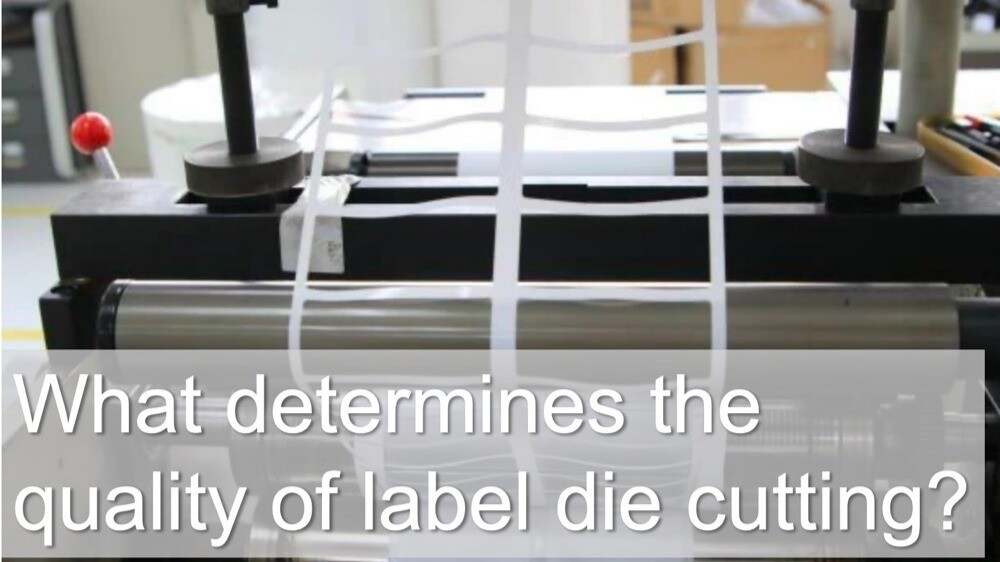Email cannot be empty
Password cannot be empty
Email format error
Email cannot be empty
Email already exists
6-20 characters(letters plus numbers only)
The password is inconsistent
Email format error
Email cannot be empty
Email does not exist
6-20 characters(letters plus numbers only)
The password is inconsistent


What determines the quality of label die cutting?
The quality of self-adhesive label die-cutting is often related to many factors, such as die-cutting method, die-cutting device accuracy, and the matching degree between die-cutting blade and material. In addition, there are many types of self-adhesive label materials. It can be said that different types of self-adhesive label materials are the arrangement and combination of different types of surface materials, adhesives and base papers, so their die-cutting characteristics are also different.
Types of surface materials
In the field of self-adhesive labels, the commonly used surface materials are paper and film. The cutting principle of ordinary paper surface materials is slightly different from that of film surface materials. Although theoretically, the surface material and adhesive must be cut through together during die-cutting, in fact, die-cutting of paper surface materials is a combination of the cutting of the tool and the self-breaking of the paper after being stressed, that is, the blade cuts downward while squeezing the paper to both sides, and the paper breaks after being stressed. Therefore, the die-cutting accuracy of paper surface materials is relatively not very high. When analyzing samples, we often see that some labels have burrs and tears. This is due to the natural breakage of the coarse fibers of the material itself.

Based on the die-cutting characteristics of paper-like surface materials and taking into account the wear of the blade, when using a flat die-cutting blade to die-cut paper-like surface materials, the blade angle is usually specified to be 52°, because the larger the die-cutting angle, the greater the extrusion deformation of the material, that is, the horizontal separation force will aggravate the breakage of the material. In actual production, some people think that the die-cutting depth of paper-like surface materials can be two-thirds of the paper thickness. If this is done, it will cause problems such as waste discharge difficulties and glue penetration. Therefore, it is recommended to cut the surface materials and adhesives 100%.
Die-cutting of film-like surface materials is simply a die-cutting process of completely cutting through. Because most film-like surface materials are tough and will not break naturally, the theory of cutting through two-thirds is not valid. The entire thickness must be completely cut through, otherwise the waste discharge edge will be peeled off together with the label.

The blade of die-cutting film-type surface materials must be sharp and hard, and a small-angle die-cutting knife should be used, and the blade angle is usually 30°~42°. If a large-angle die-cutting knife is used, not only will die-cutting be difficult, but the bottom paper will break before the surface material is cut through if the blade is not sharp. In addition, it will also cause the edge of the finished label to be flanging, causing glue seepage. In short, the precision of die-cutting film-type surface materials must be higher than that of paper-type surface materials, so die-cutting film-type surface materials has certain requirements for equipment precision, die-cutting plate precision and bottom paper.
Strength of the surface material
The strength of the surface material is related to its thickness, fiber (resin) structure and its own water content. In the die-cutting process of self-adhesive labels, the strength of the surface material has the greatest impact on the waste discharge speed, which is related to production efficiency. Usually, label printing companies hope to have a higher waste discharge speed.
In addition, the moisture content of the material will directly affect the strength of the surface material itself, and the humidity is related to the production environment. The higher the humidity, the weaker the material will be after being damp, and it will be easy to break, or even unable to discharge waste. Therefore, it is necessary to control the temperature and humidity of the production environment and storage environment to prevent the material from being damp.
In addition, when designing the layout, in addition to considering the layout graphics, it is also necessary to reasonably arrange the waste discharge size and waste discharge speed of the label according to the strength of the material through experiments, which can not only improve production efficiency, but also reduce material waste.
Thickness of surface material
The thickness of the material directly affects the depth of die cutting. The thicker the material, the easier it is to die cut. Because the thicker the material, the greater the tolerance of die cutting, and the smaller the chance of cutting through the base paper. Conversely, the thinner the material, the easier it is to cut through the base paper.

We once conducted an experiment in which we die-cut two types of surface materials with the same base paper but different quantities on the same flat-bed label die-cutter. We found that the die-cutting waste discharge of materials with larger quantities was normal, while the waste discharge of materials with smaller quantities often broke, the base paper was cut through, and the label fell off. When many label printing companies encounter such problems, they can only adopt the method of frequent shutdown and repeated plate adjustment, which wastes both time and materials. In fact, there are many reasons for such problems. If the round-to-round die-cutting method is adopted, or the die-cutting area is reduced, or high-precision equipment is used, this phenomenon can be avoided or reduced. Therefore, when die-cutting thin surface materials, it must be done on high-precision equipment. At the same time, the die-cutting area should be minimized (especially for small labels), and the die-cutting plate made by a professional die-cutting plate manufacturer should be used. In addition, attention should be paid to the plate pad accuracy.

